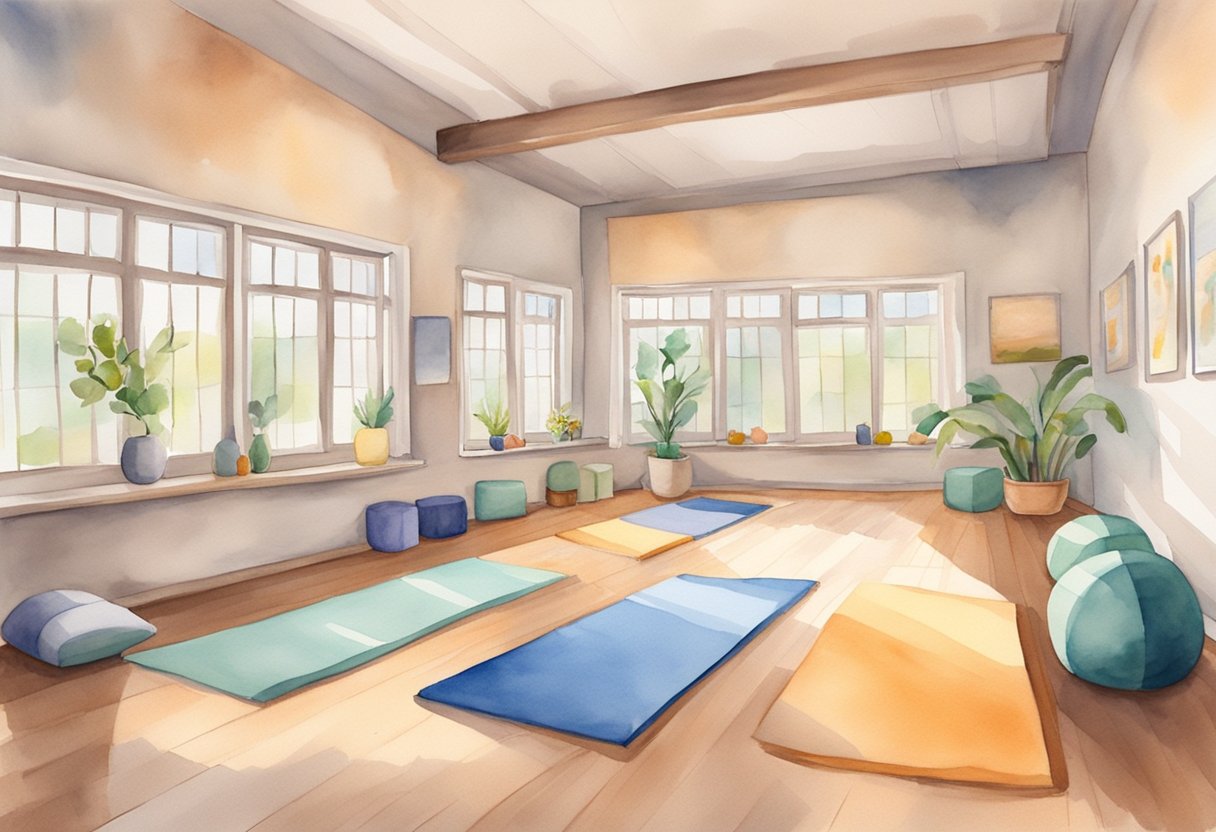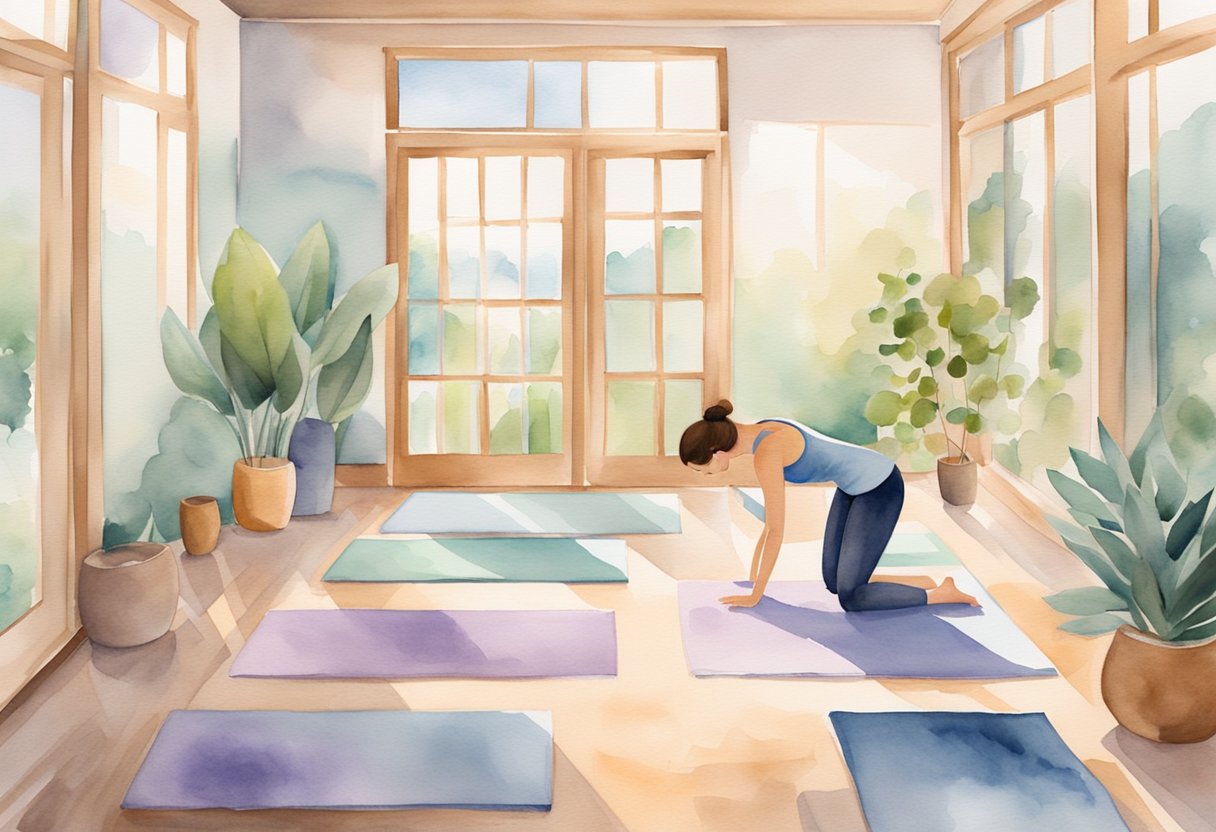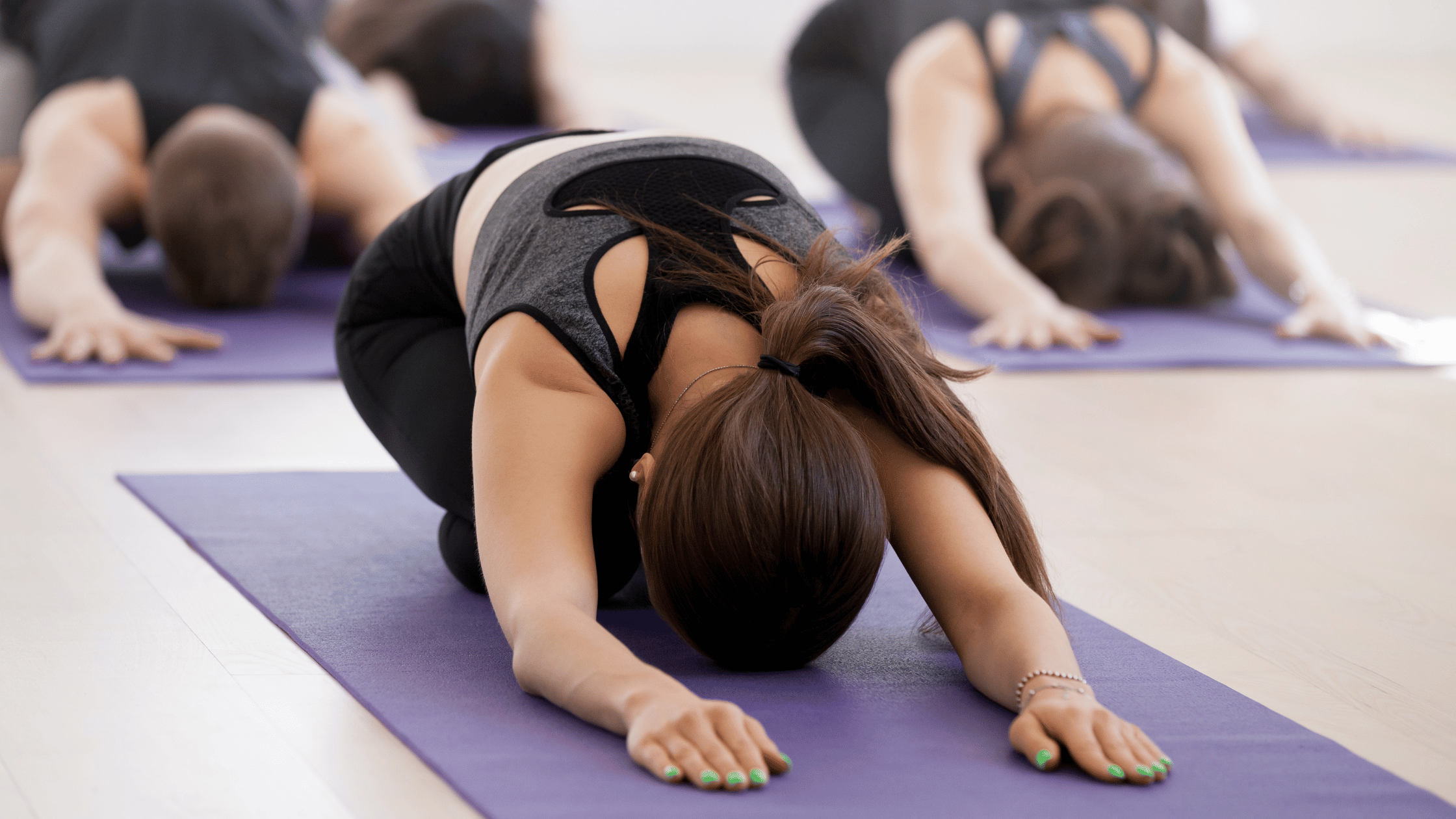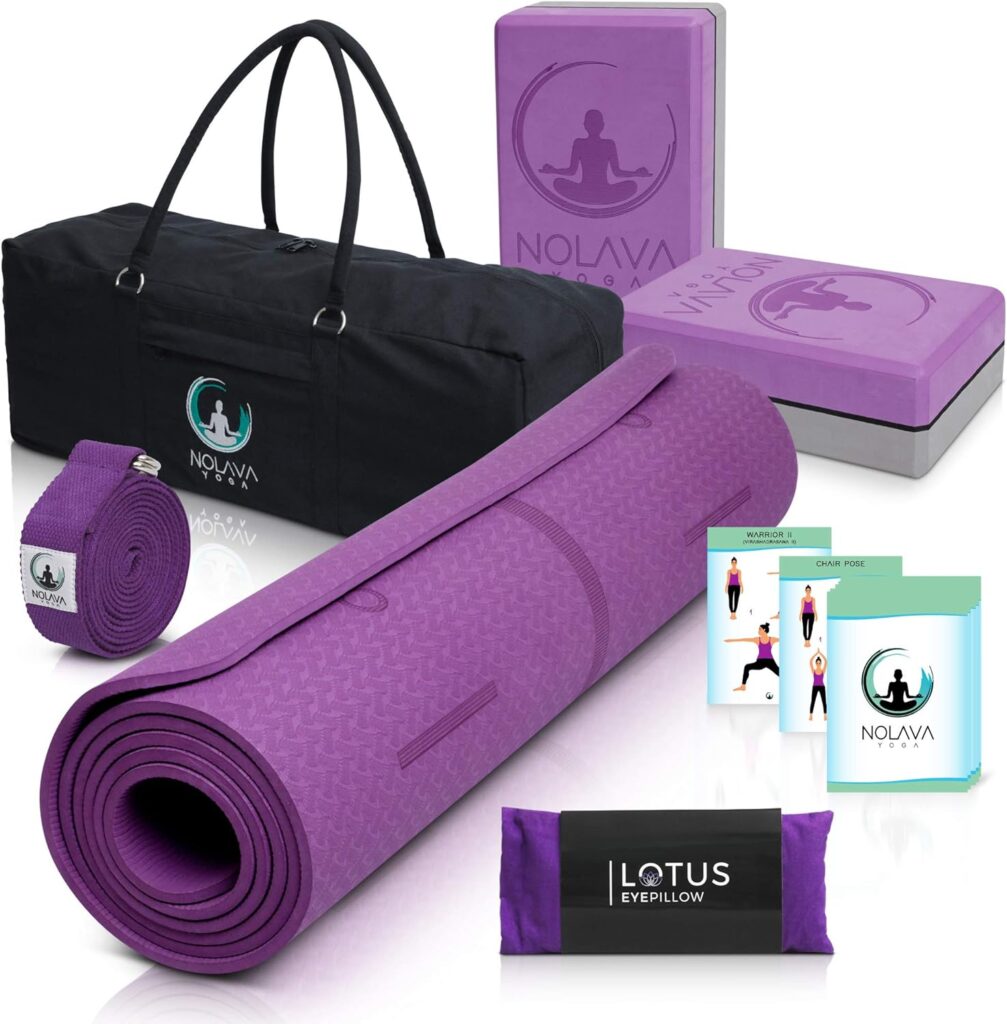Beginners Guide to Yoga as a Hobby: Mastering the Basics for a Balanced Lifestyle
Embarking on your yoga journey can be both exciting and intimidating, especially if you’re a beginner.
As you step into the world of yoga, you may wonder where to start and how to ensure you’re practicing safely and effectively.
This beginner’s guide to yoga as a hobby aims to provide you with the essential information to help you gain confidence and make the most of your practice.
This article contains affiliate links. If you make a purchase through a link on our site you are supporting our continued efforts to educate people like you in finding new and rewarding hobbies. Thank you!

Yoga offers numerous benefits for both your physical and mental health. As you explore different styles and techniques, you’ll not only improve your strength and flexibility but also benefit from reduced stress and anxiety. These advantages make yoga an ideal hobby for people of all ages and fitness levels.
When starting your yoga journey, it’s important to ease into it at your own pace. Familiarize yourself with the basic poses and concepts, find a comfortable and consistent practice space, and listen to your body’s signals. Remember, yoga is a personal experience, and your growth will come with time and dedication. Embrace this new hobby as an opportunity to explore your mind and body’s capabilities, and feel yourself flourish in the process.
Understanding the Basics of Yoga

History of Yoga
Yoga has a rich history that dates back thousands of years. It originated in ancient India as a comprehensive practice focused on mental, physical, and spiritual well-being. Over time, various styles and teachings of yoga have evolved to suit a wide range of preferences and abilities.
Different Styles of Yoga
There are many styles of yoga, each with its unique focus and intensity. Here are some of the most popular types:
- Hatha Yoga: This is a gentle style that focuses on basic poses and breathing techniques. It is suitable for beginners as it encourages relaxation and stress relief.
- Ashtanga Yoga: A more dynamic and challenging practice, Ashtanga Yoga involves a fixed sequence of poses that are performed in a specific order. This style is great for building strength and stamina.
- Bikram Yoga: Performed in a heated room, Bikram Yoga consists of a series of 26 postures and two breathing exercises. The heat helps to increase flexibility and flush toxins from the body.
- Vinyasa Yoga: In this style, poses are smoothly transitioned from one to another, in sync with your breath. Vinyasa Yoga helps improve flexibility and balance while promoting relaxation.
- Yin Yoga: A slow-paced practice wherein poses are held for longer durations, Yin Yoga targets the connective tissues and encourages mental stillness.
- Restorative Yoga: With the use of props like blankets, blocks, and bolsters, Restorative Yoga focuses on deep relaxation and healing through passive stretching.
When choosing a style of yoga, it’s essential to consider your goals, interests, and physical abilities. This will ensure you find a practice that best suits your needs and allows you to reap the full benefits of this ancient discipline.
Benefits of Regular Yoga Practice

Physical Health and Flexibility
Practicing yoga regularly can greatly improve your physical health. Yoga focuses on stretching and strengthening different muscle groups, which enhances your overall flexibility. As a beginner, you may not be able to effortlessly touch your toes or twist your body into complex poses. However, over time, your muscles will become more supple, allowing you to perform a wider range of movements with ease.
By building strength through yoga, you can also improve your posture and balance. Specific poses, such as planks and downward dogs, engage your core muscles, helping you achieve better stability and alignment.
Moreover, yoga is an excellent activity to maintain heart health. Some dynamic styles of yoga, like vinyasa and power yoga, increase your heart rate, which in turn strengthens the cardiac muscles and supports proper blood circulation.
Mental Well-Being and Stress Relief
In addition to the physical benefits, yoga is known for promoting mental well-being. Practicing yoga allows you to connect with your breath and cultivate mindfulness, which helps you become more aware of your body and thoughts. Here are some ways in which yoga can impact your mental health:
- Stress relief: Yoga’s mindful practices, like deep breathing and meditation, help activate the body’s relaxation response, reducing stress and anxiety levels.
- Enhanced mood: Regular yoga practice can improve your mood and increase the production of “feel-good” hormones, like serotonin and endorphins.
- Better focus: Concentrating on your breath and poses during yoga helps you to develop mental clarity and focus on the present moment.
In conclusion, integrating yoga into your daily routine can transform your life by offering numerous benefits for your physical and mental health. As a beginner, it’s essential to start with appropriate poses for your fitness level and gradually advance to more challenging poses to reap the rewards of regular yoga practice.
Setting Up for Success

Creating a Comfortable Space
To fully enjoy and reap the benefits of yoga, it’s essential to create a comfortable space where you can practice without distractions.
Find an area in your home that is quiet, well-ventilated, and has enough space for you to move freely. Clear any clutter to create a calm environment that invites relaxation and focus.
To enhance your comfort during practice, consider adding some cushions or a blanket to the area. As your yoga skills progress, you may also want to invest in yoga blocks or other props to help deepen your practice and provide support in various poses.
Selecting the Right Equipment
When starting yoga as a hobby, it’s crucial to choose the appropriate equipment that will support your practice. Below is a list of essential items you’ll need as a beginner:
- Yoga Mat – A good quality yoga mat is essential for providing cushioning and stability during practice. Choose one that is non-slip and has the appropriate thickness for your needs.
- Thickness options: Thin (1/16″) Standard (1/8″) Thick (1/4″) Best for travel Balanced cushion & portability Maximum cushion
- Yoga Blocks – These are useful for providing support and alignment in various poses. They come in various materials like foam, cork, or wood. Opt for the one that suits your comfort and preference.
- Yoga Strap – A strap can help you reach your limbs more easily and deepen your stretches. Try to choose one made of durable material with a secure buckle.
Make sure all of your equipment is designed for yoga and created with safety and support in mind. Using the correct props helps ensure that your practice is comfortable and enjoyable, setting you up for success on your yoga journey.
The Pillars of Yoga

Yama and Niyama
The first two pillars of yoga are Yama and Niyama. These are ethical principles that guide your behavior and personal discipline. Yama consists of five moral restraints, while Niyama includes five observances. Adhering to these principles helps to create a solid foundation for your yoga practice.
- Yama principles:
- Ahimsa (non-violence)
- Satya (truthfulness)
- Asteya (non-stealing)
- Brahmacharya (continence)
- Aparigraha (non-possessiveness)
- Niyama principles:
- Saucha (cleanliness)
- Santosha (contentment)
- Tapas (discipline)
- Svadhyaya (study of the self)
- Ishvara pranidhana (surrender to a higher power)
Incorporating Yama and Niyama into your daily life helps you to cultivate a strong ethical foundation, which is essential for the overall growth and success of your yoga practice.
Asana Practice
The third pillar of yoga is Asana, which refers to the physical postures and movement in your practice. Asanas are designed to promote flexibility, strength, and balance in your body. When you practice yoga postures, you not only work on your physical body but also develop mental focus and awareness.
Here are some tips for a successful Asana practice:
- Warm up: Properly warming up your body before starting the practice helps to prevent injuries and prepares your muscles for more challenging poses.
- Alignment: Focus on the proper alignment of your body in each pose. This ensures that you practice safely and effectively.
- Breathing: Inhale and exhale deeply and consciously while performing the postures. This helps create a strong connection between your body and mind.
- Consistency: Aim for a regular practice, even if it’s just a few minutes each day. This helps to build strength, flexibility, and balance over time.
Remember that everyone’s body is different, and it’s essential to listen to your body and modify the postures accordingly. A consistent Asana practice will enhance your physical abilities, making it easier for you to explore more advanced postures and deepen your connection to yoga as a holistic practice.
Step-by-Step Yoga Poses for Beginners

Yoga is an excellent hobby for both physical and mental well-being. As a beginner, it’s essential to start with simple and accessible poses. This guide will cover three categories of beginner yoga poses:
Standing Poses
- Mountain Pose (Tadasana): Begin by standing with your feet together. Place your arms by your sides, palms facing forward. Spread your toes and firmly ground your feet on the mat. Engage your thighs and lift your chest. Take a few deep breaths and hold the pose for 30 seconds to 1 minute.
- Tree Pose (Vrikshasana): Start in Mountain Pose. Bring your right foot up and place the sole on your left thigh or calf (avoid the knee). Your toes should point downwards, and the knee should be turned outwards. Bring your hands together at your chest in a prayer position and balance. Hold for 30 seconds to 1 minute, then switch sides.
Seated Poses
- Easy Pose (Sukhasana): Sit on the ground and cross your legs, placing one foot under the opposite thigh. Place your hands on your knees with your palms facing up. Lengthen your spine, engage your core, relax your shoulders, and breathe deeply.
- Seated Forward Bend (Paschimottanasana): Sit with your legs extended in front of you. Inhale, lengthening your spine, and exhale as you fold gently forward from the hips. Reach your hands towards your feet, placing them on your legs or holding your toes for a deeper stretch. Hold this pose for 1-3 minutes.
Resting Poses
- Child’s Pose (Balasana): Kneel down and sit on your heels. Spread your knees about hip-width apart while keeping your big toes touching. Lower your torso between your thighs and extend your arms forward with palms facing down. Rest your forehead on the ground and hold for 1-3 minutes.
- Corpse Pose (Savasana): Lie flat on your back, allowing your legs to fall open comfortably. Place your arms by your sides, with your palms facing upward. Close your eyes, take slow, deep breaths, and allow your body to relax completely. Hold for 5-10 minutes, allowing yourself to melt into stillness.
These beginner yoga poses will help you build a solid foundation as you embark on your yoga journey. Remember to stay consistent and practice with patience. With time, your flexibility and strength will improve, and you’ll be ready to explore more advanced poses.
Breathing and Meditation Techniques

Pranayama Basics
Pranayama is the practice of controlling your breath in yoga. It is essential because it serves as a foundation to access deeper levels of meditation. Here are a few basic breathing techniques to get you started:
- Ujjayi Breath: Also known as the “victorious breath” or the “oceanic breath.” To practice, gently constrict the back of your throat while inhaling and exhaling through your nose. This technique creates a soothing sound that helps you focus and connect with your breath during your yoga practice.
- Alternate Nostril Breathing (Nadi Shodhana Pranayama): This technique balances the energy channels in your body. Using your right thumb, close your right nostril, and inhale slowly through your left nostril. Close your left nostril with your right ring finger, and exhale through the right nostril. Inhale through the right nostril, then close it and exhale through the left nostril. This completes one cycle. Repeat this process for several cycles.
- Three-Part Breath (Dirga Pranayama): This technique helps expand your lung capacity and relax your mind. Inhale into your lower belly, then into your ribcage, and finally into your chest. Exhale in reverse order, releasing the air from your chest, ribcage, and belly. Repeat this process several times, focusing on each breath’s smooth transitions.
Integrating Meditation
Meditation complements your yoga practice by training your mind to control its thought patterns and sharpen your focus. Here are two meditative practices you can integrate into your yoga routine for a well-rounded practice:
- Mindfulness (Dhyana): Mindfulness is the art of being present and fully aware of the current moment without judgment. In your yoga practice, cultivate mindfulness by observing your breath, physical sensations, and mental state without reacting to them. This will help you develop a sense of inner calm and clarity.
- Concentration: To enhance your focus, choose a specific point (such as your breath or a mantra) and direct your attention to it throughout your yoga practice. If your mind begins to wander, gently bring it back to your chosen anchor. With time and practice, you’ll find your ability to concentrate in everyday life will significantly improve.
Remember, yoga is a journey of personal growth. As you explore these breathing and meditation techniques, you’ll deepen your connection with yourself and enhance your overall well-being.
Finding Guidance and Instruction

Choosing a Yoga Teacher
Finding the right yoga teacher is crucial in developing your yoga practice. It’s important to find someone who is knowledgeable, experienced, and able to cater to your specific needs. Here are some factors to consider:
- Credentials: Ensure the yoga teacher is certified from a reputable yoga school.
- Teaching style: Look for a teacher who matches your preferred style and offers clear instructions.
- Experience: Seek out a teacher with experience in the type of yoga you want to practice and understands the unique needs of beginners.
To find the perfect yoga teacher, you can:
- Ask friends or colleagues for recommendations.
- Search on social media for yoga teachers in your area.
- Visit local yoga studios and gyms to attend classes and observe the instructors.
Attending Your First Yoga Class
Attending your first yoga class might feel intimidating, but with a little preparation, you can ensure a fulfilling and enjoyable experience. Here’s what you should consider:
| Before Class | During Class | After Class |
|---|---|---|
| 1. Wear comfortable, breathable clothing. | 1. Listen to the yoga teacher’s instructions. | 1. Reflect on your experience. |
| 2. Arrive early to set up your space. | 2. Focus on your breath and body movements. | 2. Connect with the teacher and/or fellow students. |
| 3. Inform the teacher about any injuries or special needs. | 3. Avoid comparing yourself to others; focus on your journey. | 3. Stay consistent in attending classes to build your practice. |
When choosing between a yoga studio and a gym, consider the following:
- Environment: Yoga studios tend to offer a more serene, calming atmosphere than gyms, which can enhance your practice. Additionally, yoga studios often provide all necessary props and mats.
- Class Variety: Yoga studios may offer a wider variety of yoga styles and focus on specific aspects (e.g., meditation, alignment, etc.).
- Membership Benefits: Gyms might include yoga classes as part of a broader membership, while yoga studios may require separate membership fees.
Remember, it’s essential to listen to your body, stay consistent, and trust the process as you embark on your yoga journey.
Cultivating Discipline and Patience

Yoga is a practice that thrives on building discipline and patience within its practitioners. To reap the full benefits of yoga as a hobby, it is essential to cultivate these qualities. This section will guide you on how to foster discipline and patience while engaging in yoga practice.
Developing a Consistent Routine is key to maintaining discipline and realizing progress in yoga. Set aside a specific time each day for your practice, and aim for consistency. For example:
- Morning Practice: a 30-minute session before starting your day
- Mid-day Break: a 15-minute revitalizing session during lunch
- Evening Wind-Down: a 45-minute session before bedtime
By sticking to a schedule and making a commitment to your practice, you establish yoga as an integral part of your daily life, resulting in increased discipline.
Starting Small allows you to gradually build patience and discipline. Instead of diving into complex postures, begin with simpler asanas that encourage body awareness and mindfulness. Break down your practice into smaller, manageable parts such as:
- Breathing exercises
- Warm-up stretches
- Basic postures
- Final relaxation
As you gain proficiency in these foundational components, you can then progress to more demanding postures and practices, refining and mastering them with time.
Repetition fosters both discipline and patience. The more you repeat a posture, the more familiar it becomes, and the deeper you can delve into the experience. For instance:
- Sun Salutations can be repeated multiple times to create a meditative flow
- Hold Times for postures can increase, allowing you to explore nuances in your body and breath
- Difficult Poses can be revisited over several sessions, slowly growing your confidence and ability
Through repetition, you learn to appreciate the process and develop the patience required for long-term yoga practice.
Incorporate the aspects of practice, discipline, and patience into your yoga journey, building a foundation for commitment and growth. Embrace the learning process and celebrate your achievements while maintaining a humble and open mindset. By attending to both the physical and mental aspects of yoga, you will discover greater clarity, balance, and fulfillment in your practice.
Incorporating Yoga into Daily Life

Fitting Yoga into Your Schedule
Incorporating yoga into your daily life can be as simple as adjusting your routine to include as little as 10-15 minutes of practice. Here are some suggestions to help you fit yoga into your day:
- Morning: Start your day with a short routine that focuses on awakening your senses. Sun Salutations, for example, are an excellent way to greet the day and increase your energy levels.
- Lunch Break: Find a quiet space during lunch and engage in a brief practice focused on de-stressing and re-balancing, such as a guided meditation or gentle stretches.
- Evening: Dedicate some time in the evening to a calming routine, focusing on deep breaths and poses that promote relaxation like Child’s Pose or Legs Up the Wall.
Remember, consistency is key. Establishing a routine that works for your lifestyle will help facilitate your commitment to daily practice.
Yoga Beyond the Mat
Daily yoga practice isn’t limited to the mat; it’s about the balance, peace, and connection you cultivate throughout the day. Consider incorporating these aspects into your life:
- Mindfulness: Practice being present and fully engaged in each moment. This can help enhance your focus and awareness in your daily activities.
- Breath: Use conscious breathing as a tool to manage stress and maintain a calm state of mind. You can practice simple breathing exercises, such as inhaling and exhaling deeply and slowly, at any time of the day.
- Diet: Embrace a balanced and mindful approach to eating. Prioritize consuming fresh, wholesome, and nutrient-dense foods that nourish your body and support optimal well-being.
- Connection: Strengthen your connection with yourself, others, and nature. Spend time reflecting on your thoughts and feelings, engage in meaningful conversations, and appreciate the beauty of the natural world around you.
- Gratitude: Cultivate an attitude of gratitude by expressing appreciation for the gifts in your life, both big and small. Journaling or ending your day with a gratitude meditation can help you maintain a positive and appreciative state of mind.
By integrating these philosophies into your daily life, you’ll be nurturing a more profound and lasting connection with yoga, and enhancing your overall well-being.
Understanding Yoga Terminology

As you begin your yoga journey, it’s essential to familiarize yourself with some common terminology used in yoga classes and literature. This will help you better understand the instructions and deepen your practice. Here’s a brief introduction to some key terms:
Sanskrit: Yoga has its roots in ancient Indian philosophy, and many of the terms used in yoga are in Sanskrit, the classical language of India. Understanding some basic Sanskrit words and their meanings can help you appreciate the origin of yoga and make your practice more meaningful.
- Namaste: This is a customary greeting in Indian culture, often used at the beginning and end of a yoga class to express gratitude and respect. Namaste literally means “I bow to you” and is typically accompanied by a slight bow with palms pressed together at the heart.
- Mudra: A mudra is a symbolic hand gesture used in yoga and meditation to direct energy flow within the body. There are numerous mudras, each with its unique meaning and purpose. For example, Anjali Mudra (prayer position) is commonly used during Namaste.
- Yoga Sutras: This is a collection of 196 Sanskrit aphorisms attributed to the sage Patanjali and is considered the foundational text of classical yoga philosophy. The Yoga Sutras outline an eight-limbed path (known as Ashtanga Yoga) to achieving spiritual growth and self-realization. Familiarity with the concepts in the Yoga Sutras can enrich your yoga practice and understanding of its purpose.
To help you remember these terms and their meanings, here’s a quick reference table:
| Term | Description |
|---|---|
| Sanskrit | Ancient Indian language, origin of many yoga-related terms |
| Namaste | Greeting expressing gratitude and respect, accompanied by a hand gesture (Anjali Mudra) |
| Mudra | Symbolic hand gestures used to direct energy flow within the body |
| Yoga Sutras | Foundational text by Patanjali outlining the philosophy and practice of classical yoga |
By incorporating these terms into your yoga practice, you’ll develop a deeper understanding of the rich history and philosophy behind this transformative hobby. Keep learning, and don’t be afraid to ask your yoga teacher or fellow practitioners for clarification on any terms or concepts you may encounter along the way. Happy practicing!
Advancing Your Yoga Journey

Exploring Advanced Practices
As you progress in your yoga journey, you might feel drawn to explore more advanced practices. Two popular methods to deepen your practice are Ashtanga Yoga and Iyengar Yoga. Each offers unique benefits and challenges.
Ashtanga Yoga is a more physically demanding practice that focuses on strength, flexibility, and stamina. With its predefined sequences, you will move swiftly through a series of poses, synchronized with your breath. If you enjoy a dynamic and energetic practice, Ashtanga may be the right fit for you.
On the other hand, Iyengar Yoga emphasizes precision and alignment in each pose. Using various props like blocks, straps, and blankets, you will explore the subtle nuances of each posture, leading to a deeper understanding of your body. If you appreciate detail and methodical progression, consider Iyengar Yoga.
To further advance your practice, consider:
- Taking on more challenging poses: Gradually incorporate advanced poses that challenge your current abilities and explore new aspects of your body.
- Delving into the philosophy: Deepening your understanding of yoga’s historical and philosophical roots can provide a rich context for your practice.
- Exploring meditation and pranayama: Enhance your focus and inner awareness through deep breathing exercises and meditation techniques.
Connecting with the Yoga Community
Being part of a thriving yoga community can provide invaluable support and inspiration as you progress on your journey. Here are a few ways to get involved:
- Join local yoga classes: Practicing with others helps you stay motivated and learn from experienced teachers.
- Attend workshops and retreats: Immerse yourself in yoga practices by participating in workshops or attending a yoga retreat.
- Connect online: Engage with fellow yogis on social media, forums, and other online platforms to share your experiences and learn from others.
| Benefits of Joining a Yoga Community |
|---|
| Encouragement and motivation |
| A sense of belonging and camaraderie |
| Access to resources and advice |
| Networking and friendship opportunities |
| Exposure to diverse yoga styles |
By exploring advanced practices and becoming an active member of the yoga community, you will be able to fully embrace the transformative potential of yoga. Keep your mind open and stay curious, as the yoga journey is a lifelong process with countless opportunities for growth and self-discovery.
Frequently Asked Questions

How should a beginner start practicing yoga at home?
To start practicing yoga at home, begin by setting aside a dedicated space with a yoga mat and, if possible, minimal distractions.
Familiarize yourself with the basic poses and sequences by following online guides, attending beginner yoga classes, or using instructional books and videos.
Start with a gentle warm-up, then focus on your breath, maintaining proper alignment in each pose, and practicing within your range of flexibility and comfort.
What are the most suitable yoga styles for new practitioners?
Some suitable yoga styles for beginners include Hatha, Vinyasa, and Yin.
Hatha yoga focuses on static poses and breath control, making it an ideal starting point for learning proper alignment.
Vinyasa incorporates dynamic movement synchronized with the breath, creating a flowing sequence and introduces variety. Yin yoga involves holding deep stretches for longer durations, helping to increase flexibility and relaxation.
What are some essential yoga poses for those new to the practice?
Some essential yoga poses for beginners include Mountain Pose (Tadasana), Downward Facing Dog (Adho Mukha Svanasana), Child’s Pose (Balasana), Cat-Cow Pose (Marjariasana-Bitilasana), and Corpse Pose (Savasana).
These poses help build a strong foundation for further practice and ease you into understanding the mind-body connection in yoga.
Can yoga aid in weight loss for beginners, and if so, how?
Yoga can support weight loss for beginners by increasing awareness of your body’s needs, improving strength and flexibility, and promoting relaxation that reduces stress eating.
More vigorous styles like Vinyasa and Ashtanga can also contribute to calorie burning. However, it’s essential to combine yoga with a balanced diet and other forms of exercise for optimal weight loss.
Check out our other great hobby ideas for fitness and weightloss for more great ideas!
How long should a novice devote to yoga sessions daily?
A beginner can start with 20 to 30-minute yoga sessions, 3 to 5 times a week. It’s essential to give your body time to adjust and recover between practices.
As you build strength, flexibility, and confidence, you may gradually increase the duration and frequency of your sessions to suit your goals and lifestyle.
What are the recommended considerations for middle-aged beginners in yoga?
For middle-aged beginners, it’s essential to consult with a medical professional before starting any new exercise routine. Begin with gentle yoga styles and focus on modifications that address any physical limitations or conditions you may have. Prioritize listening to your body, proper alignment, and breath awareness to minimize injury risk and enjoy the benefits yoga has to offer.


